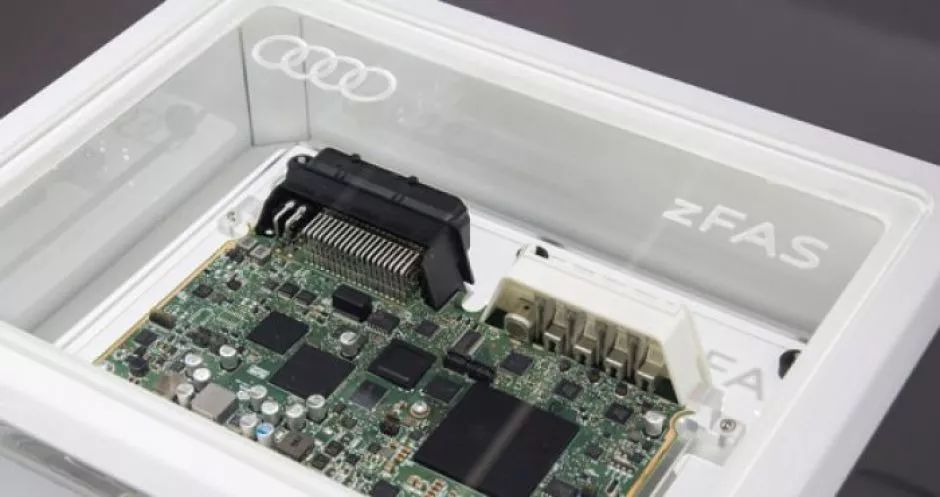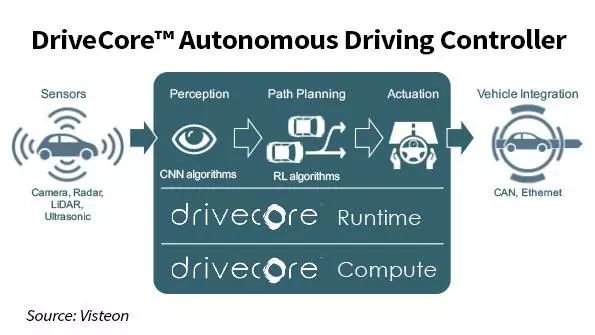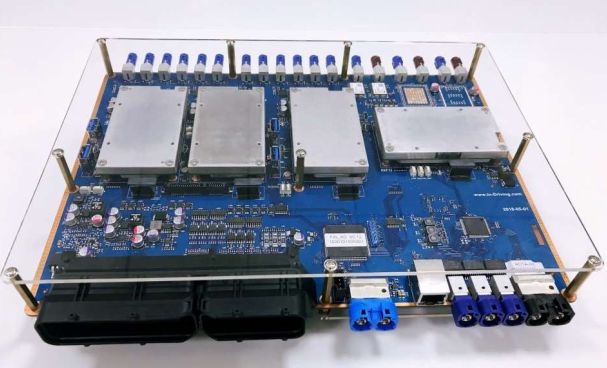On March 13, 2018, SAIC signed a joint venture contract with Austrian TTTech Computertechnik AG (hereinafter referred to as TTTech). SAIC and TTTech will set up a joint venture with 50.1:49.9 shares to jointly accelerate the development of smart driving central decision controller (iECU) integration.
This cooperation has attracted much attention, on the one hand because of the background of SAIC and on the other because TTTech is the core trader of the zFAS domain controller in Audi production cars. As a trend in the next generation of automotive electronic structures, domain controllers can perform more functions with fewer devices and at the same time have lower prices. In the case of enhanced automotive electrical characteristics, it can also facilitate the management of various subsystems and be OEM and Tier1 is generally accepted.
With the advent of autonomous driving, the sensing, control, and decision-making systems involved are more complex, and more and more information interacts and controls with other vehicle body systems. All parties hope that they can become a modular one. , portable, easy-to-manage automotive subsystems. At this point, a domain controller system specifically targeted at autonomous driving came into being.
What capabilities are required for an autonomous driving domain controller?
The autonomous driving domain controller must have multi-sensor fusion, positioning, path planning, decision control, wireless communication, and high-speed communication capabilities. Usually need to connect multiple cameras, millimeter-wave radar, laser radar, and IMU and other equipment, the completed functions include image recognition, data processing.
Due to the large number of operations to be completed, the domain controllers generally have to match a processor with a strong core computing power and can provide support for different levels of automatic driving. There are NVIDIA, Infineon, Renesas, TI, NXP, Mobileye, etc. in the industry. Multiple programs.
Different companies will choose different solutions because of different customers and needs. But there will also be some commonalities in the middle. For example, in the autopilot system, the highest demand for image processing is the image recognition part, followed by multi-sensor data processing and fusion decision.
Taking a typical zFAS as an example, this Delphi-based domain controller design product integrates the Tegra K1 processor, Mobileye's EyeQ3 chip, and Altera's Cyclone 5 FPGA chip, each of which handles different modules. Tegra K1 is used for 4-way image processing. Cyclone 5 FPGA is responsible for obstacles, map fusion and pre-processing of various sensors. EyeQ3 is responsible for forward recognition processing.

Domain control has the advantage of achieving modularity, and dividing the functionality into separate domains has many advantages. This helps to highlight the functional safety and network security requirements of various subsystems, simplifies the development and deployment of automated algorithms, and facilitates the expansion of functionality within each subsystem. Therefore, in the context of self-driving, more and more Tier1 and suppliers at home and abroad have begun to get involved in this area.
At the end of August 2017, the newly developed MAX4 autopilot platform was first announced in Magna Germany. The entire solution integrates sensor systems including cameras, high-definition radar, laser radar, and ultrasonic radar, as well as domain controller processing systems and software systems.
As a highly integrated autopilot sensor and computing platform, the MAX4 is customizable and highly expandable, enabling L4 level autopilot, suitable for both urban and highway road conditions.
ZF ProAI controllers process image and radar data. The controller is an Xavier chip with an 8-core CPU architecture and has 7 billion transistors and corresponding data processing capabilities. The processing chip can manage up to 30 trillion operations per second (TOPS), and power consumption is only 30 watts.
With its open architecture, ZF ProAI is scalable - hardware components, interconnected sensors, evaluation software and function modules can be adapted to the intended use and level of autopilot
The mainland has also introduced a similar domain controller - auxiliary and automatic driving control unit - ADCU. ADCU provides a versatile processing and computing platform that is well suited for a variety of applications in highly automated HAD. By integrating selected hardware and software, the ADCU can monitor vehicle trajectories in real time and plan paths.

Moreover, the ADCU can also execute an environmental model EM based on on-board environmental sensors and other signal inputs. The environment model covers a range of aspects from the path planning algorithm to the determination of the best path (from the perspective of safety, convenience, and environmental protection) to the coordination of multi-actuators (such as brakes, suspension control, etc.) and collaborative work.
Its interface covers the chassis, powertrain, driving assistance, a variety of communication methods (FlexRay, LIN, etc.) and is AUTOSAR architecture. It is a modular, hierarchical processing platform that supports the central domain model of vehicle topology. Host plants can make modular selections and deployments for environmental recognition or driving functions, and the expansion software can also be optimized for deployment based on the different infrastructure and computing capabilities of each vehicle.

Previously, another well-known Tier 1 Visteon has also introduced its own autonomous driving domain controller - DriveCoreTM is a safe and reliable domain controller developed specifically for autonomous driving.
The highlight of the platform is flexible, modular and customizable. DriveCoreTM can integrate a range of hardware and software platforms from different manufacturers, such as cameras, laser radar and other sensor data, all-digital instrumentation, advanced automotive display technology, driver monitoring, heads-up display, and Visteon advanced software development tools To meet the needs of different OEM autopilot technology R&D, especially the development of L3 and L3+ autopilot technology.
DriveCoreTM is similar to Visteon’s previously introduced cockpit domain controller SmartCoreTM. DriveCoreTM is capable of supporting software and hardware technologies from different vendors, and allows automakers to freely choose different hardware and software, algorithms, etc., as "Legade", to quickly develop autopilot solutions and products to accelerate new technologies or Product launch speed.
Huan Zhizhi, CEO of Huanyu Zhixing, told the "High-tech Intelligent Vehicles" that the domain controller not only solves the problem of calculation, but also needs to manage the entire autonomous driving system. Therefore, the interface is very numerous, and at the same time, there must be a strong exchange capability and the need to ensure the vehicle's Operational safety is the core of the entire automated driving system. Need to coordinate perception, planning, decision-making, control of the entire process, to achieve functional safety is very difficult.
Competing master plan
Domain controllers that want to do autonomous driving must be able to get around a mountain—a chip-level solution provider that supports computing.
The NXP BlueBox is a development platform that provides engineers with the capability to develop self-driving cars with the necessary performance, functional safety and automotive reliability. Running on it is the Automated Drive Kit software platform. As a new member of the BLBX2-xx family, the device integrates the S32V234 automotive vision and sensor fusion processor, the S2084A embedded computing processor, and the S32R27 radar microcontroller.
It is equipped with high-performance computing capabilities, with 16 GB DDR4 and 256 GB SSD, ASIL-B computing, automotive interface, with visual acceleration, ASIL-D subsystem, with dedicated interface, automotive I/O, and more Interfaces, Ethernet 100M/1G/10Gbps, SFP+, 8 x 100BASE-T1, CAN-FD, FlexRayTM, 8 x camera.
Renesas launched the Autonomy platform in 2017 to serve ADAS and autonomous driving. Corresponding to this is the R-Car Alliance (R-Car Alliance currently has more than 230 partners and Renesas Electronics based on R-Car products to develop different applications, each year the Union will meet regularly to show partners based on R-Car The latest solution made by the product), R-Car chip is mainly used for sensor acquisition analysis, as well as fusion judgment.
The Infineon AURIXTM microcontroller family is designed to meet the highest safety standards and provide powerful performance for safety-critical autopilot applications. AURIXTM can serve as a security center that supports strategic decisions and communicates with actuator systems in cars.
The system implements sensor data fusion for multiple environmental sensors (eg, radar, camera, ultrasound, and lidar), enhanced ADAS functions such as crossroads traffic assist and autonomous obstacle avoidance, requiring fusion from multiple sensors and corresponding sensors. Data, since the system can make critical autonomous decisions, Infineon's high-performance AURIXTM microcontrollers can guarantee automotive and data security, and AURIXTM, combined with the TLF35584 safe power supply and dedicated processor, can support new and enhanced ADAS functions.
Qualcomm also released the Snapdragon 820A processor for smart cars. The "A" letter stands for "Automotive", 14nm FinFET process, 64-bit Kryo quad-core CPU and Adreno 530 GPU, and supports 600Mbps high-speed LTE mobile. Internet speed. Can support access to more data, such as camera data, sensor data, etc., can provide features such as 3D navigation, face recognition, voice recognition, entertainment systems, ADAS, around the parking assistance and other functions at any time.
On the software, Qualcomm and Panasonic jointly released the car-based infotainment system based on the Xiaolong 820A, running the latest Android for Car. It is an OS created by Google specifically for cars. Google and Qualcomm have many in-depth customizations. They are the Xiaolong 820A. The above is implemented as a standard platform.
The 820A supports QNX, an on-board embedded software platform, and CarPlay and Android Auto, a bridging tool for Apple and Google connected smartphones and car platforms. The car manufacturer can remotely send the latest firmware to the owner.
According to industry insiders, TI and Freescale are relatively open, not only providing some functional interfaces, but also opening up some of the code to teach users to learn and apply. This approach is more welcomed by Tier1.
Companies such as ST, Infineon, Renesas, etc., only do more turnkey projects, and their upper application developers have low degrees of freedom and poor expansion and substitution. When OEMs choose a program, they will be given priority to factors such as cost of examination, size, and flexibility. For Tier1, there are many more options, but for small startups, there is often less choice due to factors such as a large licensing fee.
Chinese manufacturers join the track
The cooperation between SAIC and TTTech mentioned in the text is aimed at the intelligent driving central decision controller (iECU). Of course, in addition to SAIC, other domestic manufacturers are not far behind.
For high-level autopilot technology at L3 and L4 levels, Neusoft has introduced an autopilot central domain controller that fully meets the current demand for autopilot.
In terms of hardware, the controller is extremely secure and can support multiple simultaneous high-definition cameras, multiple laser lidars, millimeter-wave radars, and super-wave radars. In terms of software, the controller is highly customizable and is easy to customize for later car companies. The controller provides a development structure for development. It not only provides basic software, but also presents a complete environment awareness, sensor fusion, decision-making control suite, and provides sensor interfaces, support for OEMs and other third parties to embed their own applications, can achieve typical scenarios Automatic driving.
Neusoft Ruichi is based on the NXP's latest automatic driving chip S32V to build an autonomous driving central domain controller. The controller can integrate multiple laser radars, millimeter-wave radar and 8-channel high-definition camera, support vehicle detection in the front 160m, 100 meters pedestrian, motorcycle, bicycle detection and lane detection, moving obstacle detection, able to identify the United States, Europe, Japan, China and other countries and regions in the speed limit logo. Specific reference can be made to the local test results of the Neusoft Ruichi team in Las Vegas:
Xinyue Zhixing also released a low-cost WiseADCU based on nVidia's GPU design and development, designed for the standard nVdia Drive PX2, and integrated 12 GSM video input interfaces, 12 CAN-FD communication interfaces, and 2 AVB vehicle-mounted ethers. Network communication interface, 2+2-way USB 2.0/3.0, equipped with 2 Tegra Parker SoCs, 2 Pascal GPUs, and 2 Cortex-R5 MCUs.
In addition to the interface with the entire vehicle, it can also be seamlessly connected with HD cameras, laser radars, millimeter-wave radars, RTK/IMU positioning systems, and LTE communication modules. After the ADCU is completed, it will be sold to Chinese customers, while providing localized engineering application support services.
Wuhan Huanyu Zhixing also promoted the TITAN-III automatic driving vehicle controller this year. It is based on the Nvidia Jetson TX2 design and runs the UBUNTU operating system. Support FPDLINKIII interface camera access, support USB, CAN, RS485/232, Ethernet, IO and other hardware interface access, support SATA hard disk storage, built-in 4G communication module, high-precision positioning module, V2X module.
Computational performance and port configuration can basically meet the needs of the sensor access, perception fusion, and planning decision-making of autopilot in the current stage. It has the characteristics of small size, low power consumption and easy deployment.
Li Ming stated that TITAN-III integrates all calculation, exchange, storage and positioning chips required for L4 autopilot to ensure that there is no need to connect any other equipment. Only the camera is connected, and laser radar and millimeter-wave radar can achieve completeness. L4 level autopilot. At the same time, the interfaces meet the requirements of the vehicle regulations and support the 26262 functional safety standards, which were first introduced in the country.

TITAN-III supports the simultaneous access of 12 cameras, six laser radars, and 5 millimeter-wave radars. The total power consumption is about 60W. Before using the IPC solution. At least three to four i7 IPCs are needed to meet real-time computing needs. In addition, a gigabit switch is required to be exchanged, and the entire trunk of the vehicle will be fully occupied, and the power consumption will be over 1,500 watts.
TITAN-III software is divided into educational, OEM, and operational versions. Respectively corresponding to general R&D users (hobbyists, free of charge), depot demand (depot and internet builders, optimization of algorithm speed and performance, need to receive a one-year software service fee), and operating units (DDT and bus companies, Add cloud and scheduling management. Provide custom development.)
The requirements of three different levels can greatly speed up the deployment of L4 level autopilot for all units, and directly enter the stage of equipment R&D and small-batch testing from the functional prototype stage of IPC.
The company's next-generation products are ready to use controller versions of Xilinx's next-generation FPGAs. With the same computing power, the power consumption is only half that of Nvidia. At present, chips that support L4 level autopilot, Nvidia's advantages are greater, and the computing power is strong. The supporting development software is rich.
In addition, some start-up companies are also arranging autopilot domain controllers, such as Suzhou Zhixing Automotive Technology, and are also developing different levels of autopilot domain controllers, including Mobileye, NVIDIA, and others.
Zhi Yang Technology CEO Song Yang said that its automatic driving domain controller is more focused on being flexible and available to meet the B-side customer needs, so in the specific implementation of the program, there will be a variety of options. Domain controllers have formed a consensus in the industry. Both OEMs and Tier1 are making efforts. In the next generation of models, the concept of a part of the domain controller will be added more or less.
25*50mm Low Profile White Faceplate
included or excluded keystones for Keystones, or designed with PC board
fixtures and fittings provided
for Solid Cat 5 or Cat 6 cable
size is 25*50mm basing on UK type standard
Material as ABS, PC, PBT in UL94V-0 standards
Operation temperture -40~70 ℃
Could accept any combination of UONICRE Keystone Jack or RJ45 connectors
UK Face Plate,Outlet Face Plate,Wall Socket Face Plate,Face Plate Wall Socket
NINGBO UONICORE ELECTRONICS CO., LTD , https://www.uniconmelectronics.com